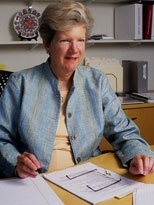In the following interview, Human Resources Vice President Alison Alden shares her vision for MIT staff and her priorities for the coming year.
Q: What is your vision for staff at MIT?
A: Just as MIT is known for its excellence in teaching and research, our goal is to build that same high level of energy and focus for learning and development opportunities on the staff side. I want employees to thrive in their jobs here and feel they are part of a world-class workplace. We need to actively invest in our staff just as we do with our students. We also need to build a more diverse and balanced employee population. To do our best work and solve the most complex problems, our staff should reflect the diversity of the community at large.
Q: What do you mean by "development?"
A: I think there are three things that characterize a workplace that values development. First, faculty and managers find ways in their daily interactions with their staff to provide encouragement and to create opportunities for growth. Second, the environment is such that employees feel empowered to seek feedback and view their development as a shared responsibility with their manager and with the Institute; in other words, they are active participants. Third, the workplace, in this case MIT, provides the infrastructure --Â the tools, programs and resources --Â to facilitate this occurring.
Q: Can you talk more about what MIT is prepared to do to support this?
A: We're still in the building phase but the foundation has certainly been laid. One current focus is extending our formal classroom training to help staff become stronger supervisors and managers. We will offer "Essentials of Managing" three times this year and are in the midst of a pilot for managers who already have some experience in their roles.
There will be a big push on the importance of giving feedback and developing our talent. Employees need to know how they're doing on the job, potential opportunities for growth on that job, and they should receive coaching/mentoring from their managers. The cycle of giving feedback is often referred to as performance development. We know that there are tremendous benefits to managers, employees and the Institute when time and thought are invested in performance development practices.
I'm also excited about a new peer connection program for support staff. The idea is to provide new MIT support staff with an experienced colleague who can help them navigate MIT during their first year. We want this to be very practical -- so new support staff learn how to get things done at MIT.
Q: What are some other priorities in the year ahead?
A: We continue to work with the Office of the Provost to identify what is important for attracting and retaining faculty. For example, accessibility of childcare is a high priority area. We also know that it's critical for new faculty and senior leaders to get support upfront when they arrive at MIT, and as result we will pilot a customized orientation program for this population.
Look for new programs and benefits related to wellness, in partnership with our colleagues at MIT Medical. We know through the hugely successful getfit program what can happen when people work together and take responsibility for a healthier MIT.
Attention also will be focused on creating programs that help people develop skills to do their jobs better and faster. Often, staff have to learn on their own, which is typically not efficient or effective. Through the work of a cross-functional group at MIT, the Training Alignment Team, training curriculum will be developed for specific roles at the Institute. First up is curriculum for people who have responsibilities for sponsored research administration.
We invite you to look for more details about these and other priorities in upcoming issues of Tech Talk.
A version of this article appeared in MIT Tech Talk on September 24, 2008 (download PDF).






